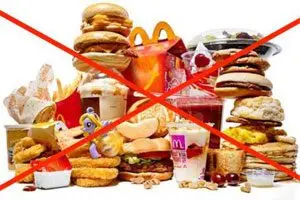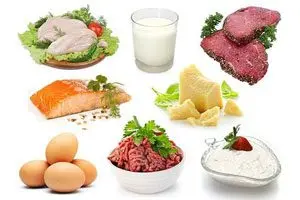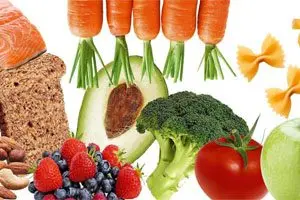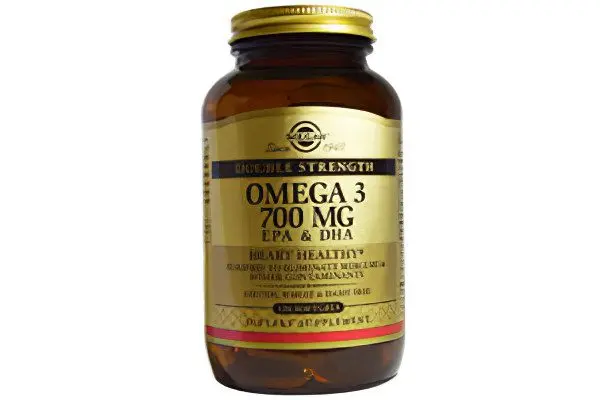Contents
It will be quite difficult to gain muscle mass solely with the help of classes in the gym. In order for the process to be launched in full force, it is necessary to adhere to a nutrition program with an emphasis on protein foods. Only in this way will it be possible to acquire a beautiful relief body, consisting of muscles, and not of fat.
Basic diet principles for gaining muscle mass

Consider the basic rules that every athlete who wants to increase muscle must adhere to:
Fractional nutrition. The number of meals per day should be at least 5. If you eat less often, but in large portions, then the body will not have time to cope with the incoming amount of food. What he is unable to process is deposited in fat.
Products must be high in calories. If the calorie content is low, then a person will have to eat more food (by volume), which is fraught with overloads of the digestive system. About 70% of all products should have a high calorie content.
Fast carbohydrates and fats should be limited on the menu. Otherwise, it will not increase muscle mass, but fat. As for fast carbohydrates (sweet fruits, flour products, sweets), they are absorbed almost instantly, so the body begins to store them “in reserve”. For the same reason, fatty foods should be avoided. First of all, this applies to sausages and lard.
Compliance with a sports diet in combination with regular training will increase muscle mass. You need to eat food 2 hours before the start of the workout and one hour after it ends.
Nutrition should be balanced:
10-20% are polyunsaturated fatty acids, which are the only sources of fat for the body;
50-60% are slow carbohydrates;
30-35% should be proteins.
Be sure to drink plenty of water, at least 2,5 liters per day. Muscle strength with insufficient intake of water in the body is reduced by 20%, which contributes to the slow growth of muscle mass.
You can’t train without breaks. Muscles grow during the rest between workouts. Stretching and adding muscle mass occurs in a period of 3 to 7 days. At this time, the load should be interspersed with periods of rest. Naturally, one should not forget about the principles of sports nutrition. If a person has just started training, then the time interval between classes should be 72 hours, and for professional athletes 36 hours is enough. You should sleep at least 8 hours a day. If possible, stress should be avoided, as cortisol levels rise in the body against the background of emotional upheavals. This, in turn, promotes fat growth and muscle burning. If you do not maintain the necessary rest intervals, then the muscles will be pumped up, and not added in mass.
Carbohydrates are burned by training. If you consume 20% more calories daily, this will allow you to build muscle mass. So that calories do not go into fat, you should drink carbohydrate cocktails 2 hours before sports activities. They are also taken 1,5 hours after training.
Cardio is not prioritized. One half-hour run per week is enough. This will help maintain cardiovascular health and increase stamina. If this condition is not met, then the muscles begin to “burn out”.
Workouts that aim to gain muscle mass should last at least 50 minutes. Moreover, the number of repetitions of strength exercises is increased to 12 times, and the number of approaches is gradually increased to five.
It should be borne in mind that the rejection of animal fats will lead to a decrease in the level of testosterone in the blood. This negatively affects the formation of muscle mass, while endurance decreases by 10%, and performance by 12%. A low testosterone level helps to reduce the concentration of lactic acid during exercise, which leads to a failure in metabolic processes, an increase in blood cholesterol levels, etc. Therefore, a person should receive at least 80 g of triglycerides per day. It is not recommended to exceed the norm of 100 g, otherwise they will begin to be deposited in fat. Therefore, it is impossible to eat snacks, margarine, mayonnaise, chips, crackers, smoked products and spreads.
At least 2 times in 30 days, you need to modify your sports program. New exercises are introduced into the training, the number of repetitions increases or decreases, etc.
Daily rate of KBJU
Daily calorie intake is calculated using the Lyle McDonald formula, or you can use a special nutrition calculator. The coefficient of energy reserve, which is necessary for the development of muscles, is 1,2. Therefore, the resulting number is multiplied by this indicator.
The coefficient K depends on the gender of the person, as well as on the speed with which metabolic processes proceed in his body.
gender | The rate of metabolic processes | K coefficient, kcal |
Woman | Slow | 31 |
Woman | Quick | 33 |
Man | Slow | 33 |
Man | Quick | 35 |
So, an example calculation:
Daily intake of kilocalories: 75 kg * 35 kcal = 2625 kcal
We multiply the resulting amount by the energy reserve factor: 2625 kcal * 1,2 u3150d XNUMX kcal.
Thus, it turns out that for a man weighing 75 kg, the daily calorie content should be equal to 3150 kcal. This will allow you to build 2 kg of muscle per month.
After determining the calorie content of the daily diet, consider the correct ratio of BJU, which make up the sports nutrition complex for muscle development:
Calculation of the daily protein intake for men: 2 g per 1 kg of weight. If he weighs 75 kg, then the daily protein intake is 150 g.
The daily amount of fat depends on the age of the man:
130-160 g – up to 28 years;
100-150 g – up to 40 years;
70 g – after 40 years.
The amount of complex carbohydrates is equal to 0,5 kg per day.
Permitted and prohibited products

Foods that should not be eaten during the diet:
Grilled meat, sausage, ham, sausages.
Products containing flavors, preservatives, flavor enhancers and other chemicals.
Butter, margarine, spread.
Fat.
Any confectionery and pastries.
Pickles, marinades, smoked products.
Protein Products

Protein foods that can be eaten during the diet:
Dietary meats. It is this meat that is the best source of protein. Professional bodybuilders eat two servings of meat every day with a volume of at least 150 g.
Chicken and turkey fillets can replace beef and lamb, as they contain a very small percentage of fat.
Milk. Fat from milk is well absorbed by the body and is not stored “in reserve”.
Dairy drinks.
Eggs. Athletes seeking to build muscle mass eat at least 10 eggs daily. They refuse the yolk.
Cottage cheese, which is a source of protein and useful trace elements.
Fatty fish, such as salmon. These foods are sources of polyunsaturated fatty acids, which are necessary for the normal functioning of the body.
Roasted and raw sunflower seeds.
Buckwheat grain.
Fresh and canned tuna.
Lentils.
carbohydrate products

Products – sources of carbohydrates that are allowed to be eaten during the diet:
Brown rice.
Fruits other than grapes, bananas and pears.
Garlic.
Vegetables, including potatoes.
Cereals.
Bread.
Greenery.
Pasta made from flour obtained from durum wheat.
Fats
Products – sources of fats:
Nuts: Almonds, cashews, hazelnuts, walnuts, and Brazil nuts.
Fatty fish.
Apple pastille.
Menu for a week of diet for gaining muscle mass
| First meal | Second meal | Third meal | Fourth meal | Fifth meal | Sixth meal |
1 | Nuts, apple, oatmeal | Chicken meat with vegetables | Banana and cottage cheese | Rice with fish and vegetables | Vegetable salad, tuna | Fruit salad |
2 | Boiled buckwheat in milk with honey, orange | Pasta, roast veal, vegetables | Whole grain bread and kefir | Kiwi, cottage cheese with honey | Baked mackerel with vegetables | Yogurt, peanut butter, fresh berries |
3 | Banana, nuts, apple, oatmeal | Low-fat part of veal, stewed vegetables | Omelet with black bread slice, apple | Fruit milk smoothie | Boiled rice with chicken | Curd with jam |
4 | Rice cooked in milk, apple, nuts | Soup with vegetables, veal | Whole grain bread, kefir | Fruit salad | Boiled turkey with baked potatoes | Vegetable salad |
5 | Stewed vegetables, scrambled eggs, chicken meat | Potato, boiled veal and banana | Apple, jam and cottage cheese | Fruit smoothies | Chicken meat, vegetables | Yogurt with strawberries and peanut butter |
6 | Banana, nuts, oatmeal | Chicken with stewed vegetables | Kefir and whole grain bread | Cottage cheese with honey and kiwi | Baked mackerel, buckwheat with vegetables | Fruit salad |
7 | Chicken, vegetables and scrambled eggs | Salad with vegetables, apple and veal | Cottage cheese, jam and banana | Fruit smoothies | Vegetables and rice, boiled chicken | Salad with vegetables |
An indicative menu for an athlete who seeks to gain muscle mass (options for 1 day):
Breakfast | Snack before workout | Dinner | Snack after workout | Dinner |
One banana, 2 slices of black bread, scrambled eggs (either 1 whole egg or two whites). | 50 g of kefir or cheese with a fat content of 1%, 2 slices of bread | ½ avocado, 0,1 kg turkey, 0,1 kg rice | 40 g nuts and gainer, 50 g dark chocolate | 0,1 kg broccoli, 0,2 kg chicken fillet, 0,1 kg rice |
One pear, 150 g oatmeal, 30 g dark chocolate, cocoa | Fat-free cottage cheese – 0,2 kg, 4 teaspoons of honey and black tea | 0,2 l soup with beef, 0,1 kg boiled buckwheat, 0,15 chicken fillet, 0,1 salad with vegetables, dried fruit compote | 0,2 kg cottage cheese, 5 teaspoons of honey, black tea | 5 egg whites, 0,15 kg vegetable salad, berry juice |
One apple, 150 g buckwheat, milk | 150 g oatmeal, 3 teaspoons jam, grapefruit | 0,1 kg of rice, 2 boiled eggs, a glass of milk | 2 bananas, 50 g of chocolate | 0,2 kg fish, orange, green tea |
100 g of cottage cheese with a fat content of 9% and yogurt, 50 g of hercules | Apple, 40 g nuts, 80 g dried fruits | 0,1 kg mashed potatoes, 0,15 chicken fillet, orange juice and banana | 0,15 g oatmeal, milk | 0,15 kg of cottage cheese, 4 teaspoons of jam, 50 g of nuts |
0,1 kg of mashed potatoes, 0,15t kg of veal, 0,1 kg of stewed vegetables, one banana | ||||
Banana, 1,5 scoops of protein, 3 slices of bread, 30 g of peanuts | Two teaspoons of honey, green tea, 0,2 l of vegetable soup, 0,2 kg of fish, 0,1 kg of rice, 0,2 kg of grapes | Smoothie with pineapple and chocolate, two slices of bread | 0,2 kg of turkey, 0,1 kg of buckwheat, 3 tablespoons of vegetable oil, 0,1 kg of salad with cabbage and carrots | |
One apple, 2 egg yolks, 4 egg whites, 50 g almonds | ||||
0,1 kg dried fruits, 40 g nuts |
Varieties of diets for mass gain

Depending on what kind of products a person prefers, diet options for mass gain will differ. There are three types of them: protein, carbohydrate and protein-carbohydrate. This also includes the energy and vegetarian diets.
Strict protein diet
A strict protein diet is followed by professional athletes before the upcoming competitions. It is aimed not only at gaining mass, but also at burning fat.
Such a diet involves a complete rejection of fatty foods and carbohydrates, but with the use of foods rich in protein. If a person’s priority is not drying, but mass gain, then such a diet will not suit him.
Protein-carbohydrate diet
A protein-carbohydrate diet is better than others for building muscle mass. The menu is designed in such a way that the body draws the energy it needs from carbohydrate foods and fat reserves, and takes the building material for muscles from protein foods. Such diets do not imply strict prohibitions, they are suitable for everyone without exception.
carbohydrate rotation diet

This diet option is gaining more and more momentum in popularity among people involved in sports every day.
It involves following 4 cycles:
Menu 1 and 2 days low-carb. The amount of protein – 3-4 g / kg, carbohydrates – 1-1,5 g / kg.
Menu 3 days: carbohydrates – 5-6 g / kg of weight, proteins – 1-1,5 g / kg of weight.
Menu 4 days: proteins 2-2,5 g / kg, carbohydrates – 2-3 g / kg.
In the first days of the diet, the body consumes glycogen and body fat stores. Muscles do not burn out, as a sufficient amount of protein is supplied with food. When the second day comes to an end, the body begins to experience stress, as it receives a very limited amount of carbohydrates, so it begins to consume body fat more slowly, slowing down metabolic processes.
To speed up the metabolism again, during the third day a person eats a sufficient amount of carbohydrate food. This misleads the body, and it continues to use fat, accumulating glycogen.
The goal of the last day is to replenish glycogen stores and prepare the body for a new diet cycle.
Vegetarian Diet
Eating plant-based foods can build muscle mass just as well as eating animal products. The menu introduces more foods rich in protein (nuts, cereals, legumes, seeds). The diet is supplemented with brewer’s yeast, vitamin and mineral complexes. You need to eat often, but in small portions. For cooking, you should use the most diverse products. So that the muscles do not burn out, but gain mass, you should eat food at least 8 times a day. At the same time, 4 approaches to the table are basic, and 4 more approaches will be additional.
Energy diet
Energy diet (Energydiet) from NL International is a popular nutrition system among athletes. The company is engaged in the production of products not only for gaining muscle mass, but also for weight loss.
Energydiet products are food supplements that need to be consumed in a specific pattern. It is made up depending on the goal pursued by a person. It should be noted that the Energydiet course requires a very impressive financial investment. As for the effect, it is quite possible to achieve it with the help of ordinary foods, but with a well-designed menu.
Sports nutrition with a diet for gaining muscle mass

Sports nutrition requires a person to strictly adhere to time frames and use specific products, which is not always possible due to various circumstances. So, it is rather problematic for a working person to eat a variety of dishes 6 times a day. Therefore, supplements come to the aid of athletes, which are designed taking into account the goals pursued.
These additives include:
Gainers. They are used to “add” the required amount of kilocalories, as well as to ensure that the protein is absorbed faster by the body. Gainers drink an hour before the start of training, so that the calories from them do not begin to be deposited in fat. You can also use them after class.
Powders based on protein. These powders are protein sources that are mixed in a gainer and drunk before workouts.
Creatinewhich helps to retain moisture in the muscles. Drink it before the upcoming workout, 40 minutes before it starts.
Glutamine. Glutamine is an amino acid found in muscles. The body produces it on its own, but athletes take it as a supplement.
Glutamine is taken before bed to achieve the following goals:
Reduce protein consumption;
Reduce muscle pain;
Activate immunity;
Stimulate the production of growth hormone;
Break down fat faster
Increase the amount of glycogen in the body;
Prevent the toxic effects of ammonia on the body.
If a person trains intensively, then he needs 4,5 times more glutamine. After all, during the growth of muscle mass in the blood, the level of glutamine drops by 18%.
An athlete consumes 5-7 g of the supplement per kg of weight per day. In adolescence, the dosage of 3-4 g per kg of body weight should not be exceeded. There are also natural foods that contain glutamine – these are eggs, fish, beef, legumes, cabbage, parsley and spinach. You can also prepare yourself a sports cocktail, for which 10 g of the supplement is diluted in 250 ml of water. They drink such a drink in the morning on an empty stomach, after playing sports and before a night’s rest.
VSAA-group. This abbreviation hides three amino acids: valine, leucine and isoleucine.

Goals that can be achieved by taking BCAA:
Reducing the harm that catabolism causes to the body (prevents the growth of muscle mass);
These amino acids are essential for protein production;
BCAAs are an additional source of energy for the body.
The more intensively a person trains, the more he needs these amino acids. If you do not replenish these reserves, the body will begin to burn muscle tissue.
There are foods that are natural sources of BCAAs – these are peanuts, tuna, eggs, turkey and chicken meat, beef and salmon. If an athlete needs BCAAs, then the supplement is introduced into the diet before training and immediately after it is completed. You can combine BCAAs with gainer, protein and keratin.
Omega 3. The purpose of taking polyunsaturated fatty acids:

Improving the functioning of the brain;
Improved blood supply;
Decreased appetite;
Normalization of metabolic processes;
Prevention of burning muscle mass;
Boosting the immune system;
Prevention of diseases of the heart and blood vessels.
Foods rich in omega-3s include: tuna, salmon, mackerel, halibut, herring, trout, flaxseed, oat germ, beans, and walnuts. The daily intake of Omega-3 should be equal to 2-3 g per kg of body weight. These healthy fats can also be taken in capsules as a dietary supplement at 2-6 grams per day.
Expert Opinion
K. Kolyaskin, MSMK on bench press:
“The success of gaining muscle mass is 60% dependent on how a person eats.
You need to eat 4-6 times a day, in small portions.
Between meals should be an interval of 2-3 hours.
The amount of protein should be at least 2 g per kg of body weight.
For one approach to the table, you need to consume no more than 30 g of protein. The body will simply not be able to assimilate large volumes.
If it is not possible to cover the daily requirement of protein with food, then it should be obtained through sports drinks.
[Video] Dr. Berg – INSULIN and muscle building. Why can’t you build muscle?










